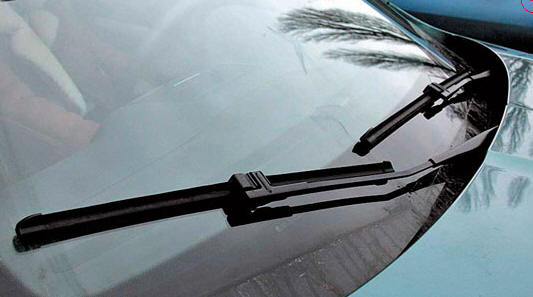
|
|
HISTORY OF TECHNOLOGY, TECHNOLOGY, OBJECTS AROUND US
Wipers. History of invention and production
Directory / The history of technology, technology, objects around us A windshield wiper (also "wiper") is a device used to remove raindrops (moisture) and dirt from a vehicle's windshield.
Brush drive options are now almost traditional for each mode of transport, but they have not developed by chance. Two basic requirements - when parking minimally interfere with the view and provide maximum cleaning coverage - lead to the traditional lower drive with parking to the right and down (for the left-hand drive position) in transport, and on tractors and special. equipment - to the top drive, since the view through the lower part of the glass of the working area of the unit is more important there. On buses, a scheme with two parallelogram bottom drives with parking to the center is common, providing almost complete cleaning of the windshield. The path of familiar car windshield wipers to the modern look took almost 60 years. It all started in the winter of 1903 in New York. One rainy day, inventor Mary Anderson was riding a tram. There was a blizzard, and the driver stopped the tram every now and then to get out and clean the glass from the adhering snow. This gave Mary an idea, and already in the fall of the same year she received a patent for a “Glass Cleaning Device”, number 743801. A hand-operated “wiper” was designed for trams, pressed against the glass by a spring, its axis passed through the frame. We didn’t even talk about cars - most of them at that time did not have windshields at all, were open, and when it rained or snowed, they remained in garages. Cars got wipers later - in 1917, when the American company Tri-Continental, or simply Tri-Co (the predecessor of the modern Trico), released the first mass-produced car wiper. The drive was manual, the wiper axis passed through the gap between the upper and lower halves of the windshield (later, when the gap began to be closed with a sealant, the "wiper" moved to the upper part of the glass). Automation came later - in 1922, Tri-Co released windshield wipers driven by vacuum in the intake manifold for the new Cadillac model. The speed of such "wipers" depended on the load on the engine, and on steep climbs they stopped working altogether. But the design was so simple and reliable that it survived until the 1960s (electric wipers were installed since 1926 mainly in luxury models). All this time, the windshield wipers regularly waved their brushes without any pause. In the 1950s, designers tried to build windshield wiper controls based on bimetallic thermal switches and vacuum systems. But the first did not work well at low temperatures, and the second - at high loads. The solution was found by Robert Kearns, an engineering professor at Wayne University in Detroit. Driving a car in rainy weather was a problem for him, because in his youth he injured his left eye. The constantly flickering windshield wipers made it even more difficult to see the road than the rain, and he thought about how to make the strokes jerky, like the movement of the eyelids. In 1963, he assembled a simple circuit from parts bought at a radio store, in which the time between pulses was determined by the charging current of the capacitor, and later offered it to Ford, which in 1969 embodied it in Mercury cars. However, Ford soon abandoned Kearns' scheme in favor of an ostensibly proprietary system. And in 1976, Kearns, having dismantled the wiper control system bought in the store, discovered that he had been robbed: Ford left his scheme practically unchanged. In 1978, he sued Ford and Chrysler, but only in 1990 won the case against Ford, and in 1995 against Chrysler. Alas, this did not bring happiness to the inventor - his life was ruined, all the money was spent on paying lawyers, and claims against other automakers were denied. Broken by Alzheimer's disease, he died in 2005 at a nursing home in Maryland. Author: S.Apresov
Artificial leather for touch emulation
15.04.2024 Petgugu Global cat litter
15.04.2024 The attractiveness of caring men
14.04.2024
▪ Flexible thermoelectric generator for powering wearable devices ▪ The best decisions are made on an empty stomach ▪ MSP-EXP430FR6989 - Extended Development Board for MSP430 with FRAM
▪ site section Lighting. Article selection ▪ article Time heals wounds. Time is the best doctor, medicine. Popular expression ▪ article Who Inspired Mexicans to Organize a Day of the Dead Costume Parade? Detailed answer ▪ Setaria article. Legends, cultivation, methods of application ▪ article Chopping an apple in half in the hands of a viewer. Focus Secret
Home page | Library | Articles | Website map | Site Reviews www.diagram.com.ua |






 Arabic
Arabic Bengali
Bengali Chinese
Chinese English
English French
French German
German Hebrew
Hebrew Hindi
Hindi Italian
Italian Japanese
Japanese Korean
Korean Malay
Malay Polish
Polish Portuguese
Portuguese Spanish
Spanish Turkish
Turkish Ukrainian
Ukrainian Vietnamese
Vietnamese


 See other articles Section
See other articles Section 